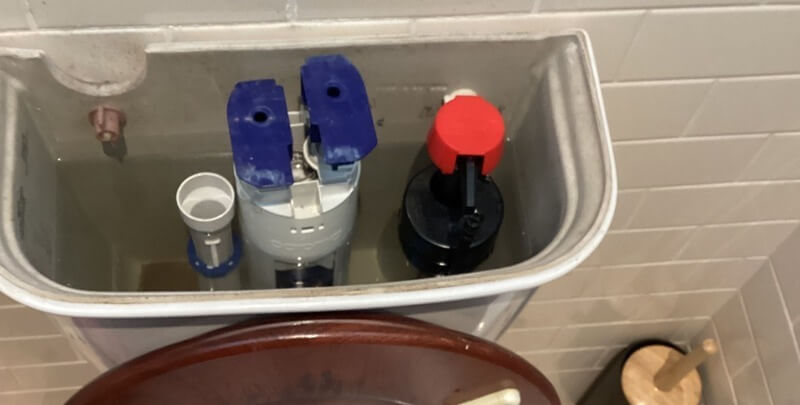
Ghost Flushing Explained & How to Prevent It
Ghost flushing – no, we're not talking about an apparition in your loo, but rather a common issue that baffles many homeowners around Australia.
You might be familiar with the phenomenon of ghost flushing, but if you’re not, here’s a quick rundown of what it’s all about.
Ghost Flushing: What Does It Mean?
Ghost flushing (also known as phantom flushing) is when your toilet flushes on its own. Just picture it: you’re minding your own business in your lounge room when out of nowhere, you hear your toilet making refill sounds with no one in the bathroom. You’ve got yourself a ghost flushing toilet.
This rather eerie occurrence can be startling and confusing. But don’t worry; there’s a perfectly logical explanation – your toilet’s internal system might be at fault.
What Causes Ghost Flushing?
While we’ve all heard the age-old saying: “If it ain’t broke, don’t fix it”, in the case of a ghost flushing toilet, it’s more like, “If it ain’t right, it probably needs a fix”.
The causes of ghost flushing lean towards the technical side of your toilet functioning, typically involving:
- An issue with the flapper in your toilet’s tank not creating a watertight seal
- An incorrectly adjusted overflow pipe
- A leak from the refill tube into the overflow pipe
- A problem with the entire flush valve
Recognising the Signs of a Ghost Flushing Toilet
It’s not just the strange toilet noises or the odd feeling of having a “haunted” bathroom. Ghost flushing is a clear indicator of water being wasted.
Each ghost flush can lose up to 2 gallons (around 7.5 litres) of water. If your toilet flushes itself about 6 times a day, that’s up to 44 litres of water wasted daily. Besides giving you a heart-stopping water bill, it’s not great for Australia’s water conservation efforts.
Given the plethora of issues that can stem out of a ghost flushing problem, it’s important to be vigilant about its early warning signs, such as the following:
- Random toilet flushes: If you notice your toilet suddenly flushing by itself with no one using it, that’s a clear indication that you have a ghost flushing toilet. These unexpected flushes can catch you off guard, and while they don’t mean your bathroom is haunted, they do signal that your toilet has something wrong with its internal workings.
- Refilling sounds without flushing: Suppose you hear your toilet making refill noises without anyone having recently used it. If the toilet keeps making these odd sounds even after adjusting the handle, it’s another warning sign of phantom flushing. The refilling sound means that you’re losing water, and there’s likely a problem with components like the flapper, fill valve, or overflow pipe.
- High water bills: If you find yourself facing a large water bill, and you can’t explain the significant increase, it might be time to check for ghost flushing in your bathroom. Ghost flushing results in water wastage of about 2 gallons (around 7.5 litres) per flush. And since it’s flushing on its own throughout the day, that can add up quickly, leading to high water usage and bigger bills. Keep an eye out on your water bill to catch any ghost flushing issues.
- Water leaks around the toilet base: If you spot an external toilet leak, don’t dismiss it. This might be a sign that your toilet tank is overflowing due to ghost flushing. Noticing any external or internal leak near the base can be an indirect sign that your toilet is experiencing phantom flushing and needs attention before it causes more damage.

How to Diagnose a Ghost Flushing Toilet
The first step in diagnosing a ghost flush involves observation. Look for visible leaks around the toilet, as an external leak might be causing the strange flushing.
Next, check the internal workings of your toilet. Remember, only explore areas that you feel comfortable dealing with. For any doubt, call a professional plumber to prevent significant damage.
In your investigation, pay keen attention to three key toilet fitting components:
- The flush valve: Is the entire flush valve damaged or not sealed properly?
- The refill tube: Is it inserting water directly into the overflow pipe?
- The overflow pipe: Is it set too high in relation to critical components like the flapper?
To do this, simply remove the tank lid – no tools are required.
Inside your toilet tank, you’ll see the refill tube – a small flexible water supply tube – that should be aimed into the overflow pipe but not inserted into it.
Also, observe the flush valve to see if the flapper is sealed effectively against the valve’s surface area. If it is not, it’s time either to replace the flapper or clean the flush valve’s surface.
Fixing Ghost Flushing
Firstly, inspect your flapper. If it’s visibly damaged or overly flexible, you’ll likely need to replace it. To do so, disconnect it from both the overflow tube and the bottom of the tank, attach the new flapper, and hook it back to the overflow tube.
On the other hand, if the flapper looks okay, it could be an issue with your refill tube. Ensure it discharges water directly into the overflow pipe and not inside it. If it’s inside, gently move it so it sits above but is aligned with the overflow.
This toilet doctoring process aims to confirm which parts aren’t working optimally. If you need to replace the entire internal system, including the fill valve, flush valve and flapper, it’s best to call a professional plumber.
Ghost Flushing Prevention Tips
As the old saying goes, “prevention is better than cure”, so here are some tips on how to prevent ghost flushing:
- Regular inspection and maintenance: Preventing ghost flushing starts with regularly inspecting your toilet’s components, mate. By giving your toilet a once-over, you’ll be able to pinpoint problems before they get bigger. Have a look at the fill valve, flush valve, refill tube, and toilet flapper to make sure everything’s in good nick.
- Keep an eye on the flapper: The flapper plays a key role when it comes to stopping ghost flushing. Be sure that:
- The rubber flapper is seated correctly on the flush valve.
- The flapper isn’t damaged or hardened over time (if it is, replace it).
- The flapper returns properly to its position at the bottom of the tank without any obstruction.
- Replace the flapper every couple of years to prevent any issues that might lead to ghost flushing.
- Manage the water level correctly: To put ghost flushing to bed, you’ve got to manage the water supply and maintain the right water level in your toilet tank. If the water supply valve isn’t working properly, or the fill valve isn’t adjusted just right, the tank could become overfilled. This excess water might spill into the overflow pipe, leading to a ghost flushing situation.
- Check the overflow pipe and refill tube: A wonky overflow pipe and a misplaced refill tube can be big culprits behind ghost flushing. To avoid any unexpected flushes:
- Make sure the overflow pipe isn’t set too high in your tank. It should be around 1 inch below the opening at the top of the pipe.
- The refill tube should aim into the overflow pipe, but not be inserted into it. If the tube dispenses water directly into the pipe, you might end up with a ghost flush.
- Inspect the chain length: Another common cause of ghost flushing is when the chain attached to the flapper is either too short or too long to do its job effectively. Make sure the chain is of the correct length, allowing the flapper to seal properly.
- Use a dye test: If you want to identify leaks that potentially cause ghost flushing, use a dye test. Put a dye tab or a few drops of food colouring in the tank and wait. If the colour appears in the bowl within 15 minutes without flushing, you have a leak that could be causing ghost flushing.
- Install a fill cycle diverter: Add a fill cycle diverter to your toilet’s fill valve if it doesn’t already have one. This handy device shoots more water into the bowl during the refill process rather than into the tank, helping save water and potentially preventing overflow issues and ghost flushing.
- Decrease float height: Lowering the float height in your toilet can help control the water level in your toilet tank and prevent overflow. If the cracking sound of phantom flushing is haunting you, try adjusting the float to lower the water level.
Remember, if all else fails or if the problem worsens, getting help from a professional plumber is your best bet to exorcise the ghost from your toilet bowl. Not only does it save you the hassle, but it also ensures proper diagnosis and repair.

When to Seek Professional Help
Sure, there are a few steps you can take to try and fix a faulty toilet flushing. Still, if you’re finding that the problem persists and you’re constantly asking: “Why is my toilet randomly running?”
It might be time to call in a professional. Toilet ghost flushing can cause some extensive damage if not tended to promptly, so it’s essential to approach it methodically and swiftly.
Plumbing problems can be tricky and often linked to even broader issues – even the pipes and sewage systems that run into your home. If in doubt, always contact a trusted professional because sometimes, the solution’s not always visible at first flush.
Please note: This information is provided for advice purposes only. Regulations differ from state to state, so please consult your local authorities or an industry professional before proceeding with any work. See our Terms & Conditions here.